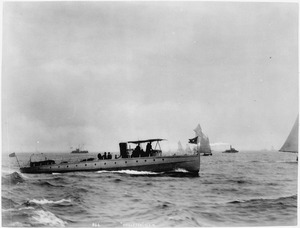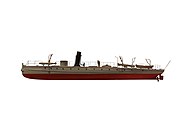
USS Vesuvius, the third ship of the United States Navy named for the Italian volcano, was a unique vessel in the Navy inventory which marked a departure from more conventional forms of main battery armament. She is considered a dynamite gun cruiser and was essentially an operational testbed for large dynamite guns.
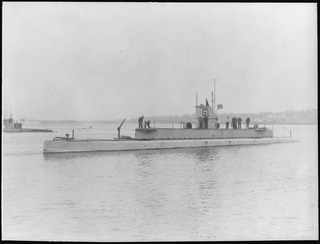
USS G-1 (SS-19½) was the lead ship of her class of submarine of the United States Navy. While the four G-boats were nominally all of a class, they differed enough in significant details that they are sometimes considered to be four unique boats, each in a class by herself.

USS G-2 (SS-27) was a G-class submarine of the United States Navy. While the four G-boats were nominally all of a class, they differed enough in significant details that they are sometimes considered to be four unique boats, each in a class by herself. G-2 was named Tuna when her keel was laid down on 20 October 1909 by the Lake Torpedo Boat Company in Bridgeport, Connecticut, making her the first ship of the United States Navy to be named for the tuna, a large, vigorous, spiny-finned fish highly esteemed for sport and food. She was renamed G-2 on 17 November 1911, launched on 10 January 1912 sponsored by Ms. Marjorie F. Miller, towed to the New York Navy Yard after the termination of the Lake contract on 7 November 1913 where she was completed, and commissioned on 1 December 1913.

USS Cushing was a torpedo boat in the United States Navy during the Spanish–American War. She was named for William B. Cushing.

Nathanael Greene Herreshoff was an American naval architect, mechanical engineer, and yacht design innovator. He produced a succession of undefeated America's Cup defenders between 1893 and 1920.

USS Alcedo (SP-166) was a yacht in the United States Navy. She was the first American vessel lost in World War I.

The first USS Talbot was a torpedo boat in the United States Navy.

USS Porter was a torpedo boat, the first of her class, launched in 1896, served during the Spanish–American War, and struck in 1912. She was the first Navy ship named for Commodore David Porter, and his son, Admiral David Dixon Porter.

USS Winslow was a United States Navy torpedo boat noted for its involvement at the First and Second Battle of Cardenas during the Spanish–American War. She was named for Rear Admiral John Ancrum Winslow.
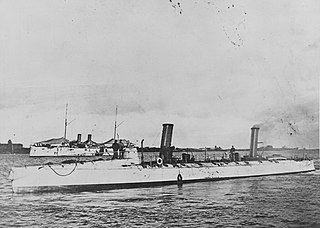
The first USS Ericsson was the second torpedo boat built for the United States Navy. The first,Cushing, had been built seven years earlier.

The first USS Du Pont was launched 30 March 1897 by Herreshoff Manufacturing Co., Bristol, R.I.; sponsored by Miss L. Converse; and commissioned 23 September 1897, Lieutenant Spencer S. Wood in command.

The first USS Gwin, was launched 15 November 1897 by the Herreshoff Manufacturing Co., Bristol, Rhode Island, and commissioned at Newport 4 April 1898, Lt, (j.g.) C. S. Williams in command.

The first USS Blakely was laid down on 12 January 1899 at South Boston, Massachusetts, by George Lawley & Son and launched on 22 November 1900. Sponsored by Miss Nellie M. White; and commissioned on 27 December 1904. It was named for Johnston Blakeley, commander of USS Wasp.

The first USS Leyden was a screw steamer that operated as a tug in the U.S. Navy from 1866 to 1903 and saw combat service in the Spanish–American War in 1898.

SMS Tiger was a torpedo cruiser built for the Austro-Hungarian Navy in the mid-1880s. An enlarged and improved version of the Panther class, she was part of a program to build up Austria-Hungary's fleet of torpedo craft in the 1880s. The Panther class, purchased from a British shipyard, was acquired in part to gain experience building cruisers of the type; this provided the basis for the design of Tiger. She was laid down at the Stabilimento Tecnico Triestino shipyard in October 1886, she was launched in June 1887, and was completed in March 1888. The ship was armed with a battery of four 12 cm (4.7 in) guns and three 35 cm (14 in) torpedo tubes, and was capable of speeds in excess of 19 knots.
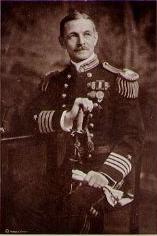
Rear Admiral Spencer Shepard Wood was a United States Navy officer. His career included service in the Spanish–American War and World War I, command of battleships and cruisers, and duty as an aide to a number of senior naval leaders.

The Peoria, a converted steel gunboat, was built as the pilot boat Philadelphia by Neafie and Levy ship and engine building company in Philadelphia, Pennsylvania in March 1896 for the Pennsylvania and Delaware Pilots' Association. The Philadelphia was purchased by the US Navy on 23 May 1898 from the Philadelphia Pilots' Association, and was renamed Peoria. She was commissioned on 15 May 1898.

USS Helianthus (SP-585) was a patrol vessel in commission in the United States Navy from 1917 to 1919, seeing service in World War I. After her U.S. Navy service, she was in commission in the United States Coast and Geodetic Survey as the survey launch USC&GS Helianthus from 1919 to 1939. She was named after the Helianthus, the genus to which the sunflower belongs.
HMS TB 81, originally named Swift, was a torpedo boat that served with the British Royal Navy. She was built in 1884–1885 by the shipbuilder J Samuel White as a private venture, and was purchased for the Royal Navy in 1885, and was one of the largest torpedo boats of her time. She remained in service into the First World War, when she was employed as a patrol boat, finally being sold for scrap in 1921.
